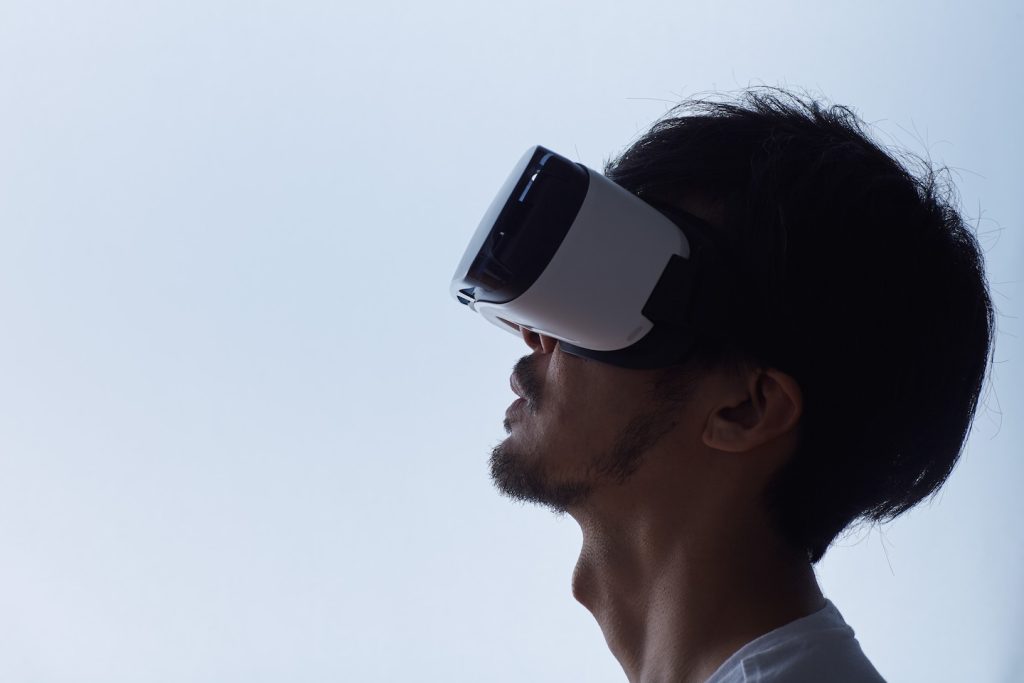The house shook so much when he fell, his wife and kids came running. They found Mingione lying on the floor in pain, pieces of the remotes and batteries scattered around him.
“I told them I was fine, but my knee was killing me,” Mingione said. “… When I fell, what stopped me was the floor, not my hands, or anything.”
His knee and elbow swelled up painfully and continued to ache for about four weeks. He hasn’t touched the headset or any other game since: “I’m retired,” he said.
Mingione was luckier than a friend who was wearing a VR headset in a virtual boxing match as his family watched. A family member said, “You know you can kick, too,” and so his friend kicked into the air as hard as he could — and broke his toe on a coffee table.
“You definitely have to be careful, because you can’t see a thing while you play,” Mingione said.
Injuries are rising
As the number of people using VR headsets rises, so, too, are the number of people injured when the virtual world crashes — literally — into the real one.
Sales of virtual reality headsets rose from $4.42 million in 2018 to $21.76 million last year and are expected to reach $27.26 million in 2028, according to Statista Market Insights, which also reported more than 5.4 million units were sold in 2019 and more than a projected 14 million for this year. Headsets cost from several hundred to several thousand dollars.
A study published last year found just 125 incidents of VR-related injuries were reported to emergency rooms in 2017. By 2021, that figure was estimated at 1,336, the study found, using data from the National Electronic Injury Surveillance System, known as NEISS.
According to Melissa Kovacs, an associate professor of trauma research at Dignity Health Medical Group in Chandler, Ariz., and the study’s co-author, unofficial figures from 2022 that she’s seen show a 100 percent increase since 2021 in VR-related emergency room visits reflecting the rise in sales and use of the headsets.
She added the number of injuries is probably much higher than the NEISS figures, since those reflect only people who went to ERs, not those who went to doctor’s offices or urgent care or who dealt with injuries at home.
“These injury numbers, they are small, but they are increasing, kind of really alarmingly quickly,” Kovacs said.
Daniel Cucher, a trauma surgeon who works with Kovacs at Dignity Health and is a co-author of the study published last year, said that after trying one of the VR headsets himself, he understands how people get injured. “It’s quite a physical engagement,” he said, and “they’re typically used in people’s living rooms or their basements or enclosed spaces, where they’re predisposed to injury if they’re flailing around wildly with their headset on” and cannot see, or sense, the real world of walls, ottomans and chairs around them.
Fractures, lacerations, strains or sprains
According to the study, the most common VR-related injury, accounting for 30 percent of ER visits, was a fracture, followed by lacerations, at 18.6 percent, contusions at about 14 percent, and strains or sprains, which accounted for 10 percent, according to the data.
Young children, up to the age of 5, were most likely to injure their face, while those 6 to 18, were most likely to hurt their hands or their face. Adults, up to the age of 54, primarily hurt their knees, finger and wrists, while the majority of people over 55 hurt their upper trunk and upper arm.
Among the NEISS cases were: a 60-year-old man who ran into an object, striking his chest on the wall and suffering a contusion to his ribs and dental pain; a 13-year-old boy who ran into a table, lacerating his face; a 9-year-old who dove and hit his face on a television stand, giving himself a dental injury and cutting his upper lip; and a 12-year-old who was evaluated for a head injury after leaning onto a virtual shelf that caused him to fall into a real shelf.
A lot of the VR-related injuries are from a direct blow or strike on a hard object, like a wall or a table or a door jam, said Hilton Phillip Gottschalk, an orthopedic hand surgeon in Austin, who has treated a number people with such injuries.
When his son plays a VR game called “Gorilla Tag,” Gottschalk said, he has no idea where the walls or tables or couches are located. When he swings at something in the virtual game, he could easily hit a real object in the room with a lot of force without knowing it was there.
“There are some percentage [of injuries] that are gonna be a fall from maybe some dizziness or tripping or something. But most of these are really a direct blow, a direct contact. The hand hits the wall, the hand hits the couch, the hand hits the table,” Gottschalk said.
Bryce Gillespie, an orthopedic surgeon in Atlanta who specializes in hands and upper extremities, wrote in an email that the most common VR injuries he sees are finger fractures. Fortunately, most simply require a cast and not surgery, he wrote in an email.
“The injuries I’ve seen are typically teenage boys using VR headsets while playing games” at home, Gillespie wrote. “They lose track of what objects are around them. Some have tripped over a table and landed on their hands. Others have simply turned around quickly and struck a door jam with their hands.”
Recently, he treated a 12-year-old boy who was playing a VR game and slammed his hand into a door jam while swinging his arms in defense, breaking multiple fingers. And a 14-year-old boy came to see him after he tripped over a coffee table, falling and breaking bones in his hand while playing a VR sports game.
Headsets can be disorienting
Jennifer Weiss, chief of staff at the Shriners Children’s Hospital in Honolulu, treated a 13-year-old boy recently who’d sprained his ankle and wound up in an air cast even though he’d set up his game to make sure there were no objects to hit or trip over. “It wasn’t even that there was something there to stumble on. It was just his proprioception was funky,” she said, referring to the ability to know where your body is in relation to the space around you. “He misjudged where the floor was.”
She knows that feeling, Weiss said. She recently did a virtual reality mock-up of an operating room, and she said wearing the headset was disorienting.
“When I have played around with [the VR glasses] … it’s kind of like walking in the dark,” she said. “Even if there’s nothing to trip over, it’s just a different sensation of where your body is.”
Brian A. Janz, a plastic and reconstructive surgeon in Catonsville, Md., who specializes on hands and upper extremities, said the rise in VR-related injuries is similar to what happened some years ago when people began buying hoverboards, two-wheeled self-balancing scooters that people steer by leaning forward, backward, right or left.
A child would get one for Christmas, and then the adults would try it and get injured. “I’ve seen injuries very similar to the hoverboards, where parents and grandparents [are] trying out the VR, and then getting unstable or not feeling good balance and falling and winding up with wrist sprains or wrist fractures,” he said. With hoverboards, eventually people grew accustomed to riding them and the flow of injuries ebbed. The same is likely happen with VR, he said.
VR device manufacturers provide rules for safe use of their products, including using them in an unobstructed space and setting up play boundaries in the headset, so that play won’t venture into areas encumbered by real-world objects. If the user steps beyond the boundaries, the device alerts them.
Kate McLaughlin, a spokesperson for Meta, which manufactures a lineup of Quest VR headsets, responded to questions about injuries by pointing to the company’s safety instructions. “Here is our Meta Quest Safety Center, which is where we help educate people on how to stay safe while using Meta Quest products,” she wrote in an email.
Apple, which manufactures Apple Vision Pro, also pointed to its safety guidelines and noted that its product “uses the most natural and intuitive inputs possible — a user’s eyes, hands and voice,” Andrea Schubert, a public relations manager at Apple, wrote in an email. “Apple Vision Pro is a spatial computer that blends digital content with the physical world while allowing users to stay present and connected to others (users can see the world around them from the moment they put on the device).”
In the ideal world, that may be true. “But let’s be honest,” Gottschalk said. “As you’re making a quick movement, it’s not like you have time to react, right? If you’re close to that border, and you do a quick maneuver, a quick move with your hand, by the time you get that alert, it’s over. You’ve already done the damage.”
#Virtual #reality #users #break #bones #suffer #cuts #bruises #playing,
#Virtual #reality #users #break #bones #suffer #cuts #bruises #playing


